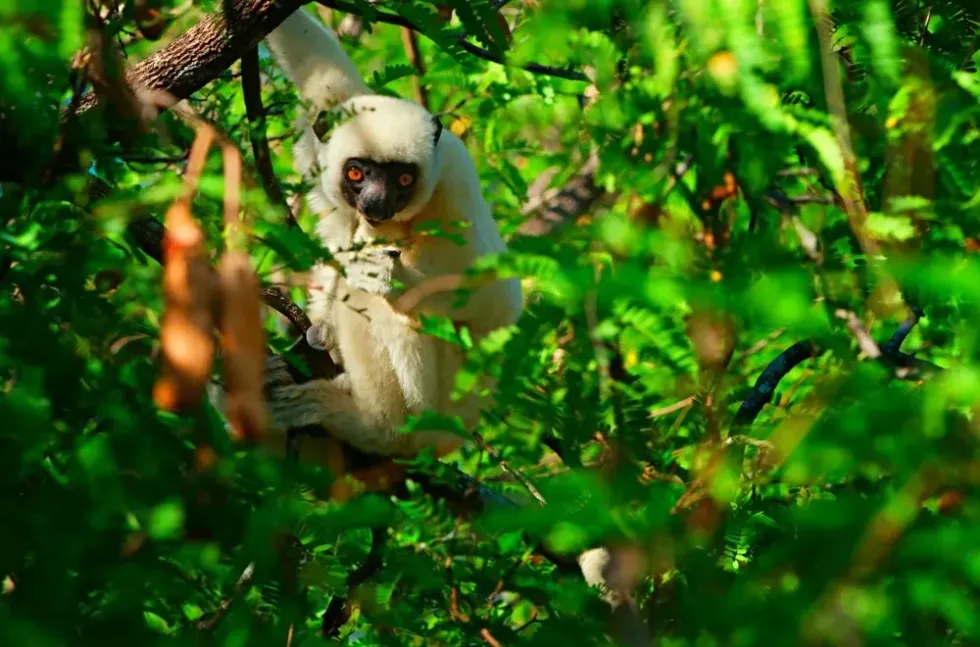Do you like reading about unique animals? In this article, we will learn about the smallest sifakas in the world- the golden-crowned sifakas (Propithecus tattersalli).
They are found in dry and isolated forest fragments in Madagascar. Golden-crowned sifakas are also known as Tattersall's sifaka and are named after their discoverer, Dr.Ian Tatersall. This animal has mostly white fur which has a golden tint.
It also has strong and long legs that help in climbing and leaping from trees in forests. These animals are very social and live in groups of 10-12. The females are the rulers of this group and responsible for making decisions for their food and potential mates.
They are very territorial in nature and mark their territories with urine and scent. These creatures are known as 'sifakas' due to their similar sounding call 'shee-fak'.
This call helps them in finding other lemurs. The sifakas are mostly diurnal but during the rainy season, they become active in the morning and evening.
Unfortunately, these species, have been listed as Critically Endangered. Human activities like slash and burn agriculture, logging, deforestation and more recently, gold mining and hunting have resulted in a drastic decline in their population. Keep reading to find out more about this fascinating species.
For more relatable content, check out these ring-tailed lemur facts and Chinese water deer facts for kids.
Golden-Crowned Sifaka Interesting Facts
What type of animal is a golden-crowned sifaka?
The golden-crowned sifaka is a type of lemur. It is also known by the name Tattersall's sifaka.
What class of animal does a golden-crowned sifaka belong to?
The golden-crowned sifaka belongs to the class Mammalia and the family Indriidae.
How many golden-crowned sifakas are there in the world?
The golden-crowned sifaka population has been declining. The International Union for Conservation of Nature has listed them as Critically Endangered. About 4000-5000 individuals of this species are remaining.
Where does a golden-crowned sifaka live?
The golden-crowned sifaka has independently evolved on an island in northeast Madagascar. It can be found in the town of Daraina, and in a select few forest patches in Madagascar.
What is a golden-crowned sifaka's habitat?
These sifakas prefer sleeping in tall, green trees and can be found living in isolated semi-evergreen and dry deciduous forest fragments. These animals are not found at altitudes exceeding 2296.6 ft (700 m).
Who do golden-crowned sifakas live with?
Golden-crowned sifakas are highly social and prefer living in groups. These groups may contain up to 10 individuals with a minimum of two members of each sex. The females are the dominants and get the choice of choosing their mating partners.
How long does a golden-crowned sifaka live?
The golden-crowned sifakas' population can live up to 20 years.
How do they reproduce?
The sifakas are seasonal breeders. Their mating season lasts from January and March. Female golden-crowned sifakas reproduce once in two years and give birth to a single baby. The gestation period lasts for about six months.
The infants have little hair and cling close to their mother bellies until weaning starts at five months of age. The offspring are taken care of by the mother. After attaining sexual maturity at two or three years, the sifakas no longer stay in their natal group and move towards other social groups.
What is their conservation status?
The golden-crowned sifakas have been listed as Critically Endangered by the International Union for Conservation of Nature or IUCN in the Red List of Threatened Species. Their population has been on a decline with only 4000-5000 individuals remaining.
Golden-Crowned Sifaka Fun Facts
What do golden-crowned sifakas look like?
These lemurs, as their name suggests have a distinctive golden-orange crown. Their ears are mostly made up of white fur and are tufted.
They have a black face and a creamy-white fur coat which has a golden tint. A blunt snout, a broad nose, and bright orange eyes help in distinguishing them from other sifakas. It also has strong legs that help it to climb and leap between trees just like an aye-aye.
How cute are they?
The golden-crowned sifaka appears to be pretty cute. Just like a white-bellied spider monkey, these lemurs look adorable while they climb on trees.
How do they communicate?
They have a large range of vocalizations. These sifakas are known to be more volatile than others and may engage themselves in growling and grunting to portray annoyance.
They make the sound 'sifaka' (shee-fak) for threats on the ground. Along with these, marking territories with their scent, urine, and body postures are other ways in which they communicate with other animals.
How big is a golden-crowned sifaka?
Golden-crowned sifaka populations have tails that are about 17-19 in (43.18-48.26 cm)long and have a total length of 34-37 in (86.36-93.98 cm). These lemurs have a size similar to a langur monkey.
How fast can a golden-crowned sifaka move?
The speed of golden-crowned sifaka is not known. lemurs in general, however, can move at speeds of up to 12 mph (19.31 kph). These speeds can give us an idea about the movement of golden-crowned sifakas as well. These sifakas cover distances of about 1515-3533 ft (461.7-1076.8 m) in a day.
How much does a golden-crowned sifaka weigh?
The golden-crowned sifaka weighs about 7.5-7.9 lb (3.4-3.5 kg) and is one of the smallest sifaka species.
What are the male and female names of the species?
There are no unique names used to identify the male and female golden-crowned sifakas.
What would you call a baby golden-crowned sifaka?
A golden-crowned sifaka baby can be referred to as a pup. The lemur pups cling close to their mother's belly until they are a few weeks old.
What do they eat?
These lemurs are herbivores and their diet differs slightly each season. The majority of their diet consists of plants, unripe fruits, seeds, grains, leaves, and flowers. During the dry season, the golden-crowned sifakas also feed on barks of trees, wood.
In the wet season, flowers and immature leaves make up their diet. A varied mix of plants, nuts, seeds, and grains is a must for the golden-crowned sifakas. This varied diet composed of different elements keeps it protected from plant toxins.
Are they dangerous?
The golden-crowned sifakas are not known to be harmful to humans. However, lemurs have very sharp teeth that can cause pain so it is better to practice caution.
Would they make a good pet?
Lemurs are highly social animals that cannot be domesticated. They prefer to stay in groups and will not do well in isolation. The golden-crowned sifakas especially should not even be considered for domestication as its population has been on a decline.
Did you know...
The golden-crowned sifaka feeds on as many as 80 different species of plants.
These animals have a specific alarm call for avian predators.
This lemur is very territorial in nature. The golden-crowned sifaka males mark their home range which is about 22-30 acres with urine and scent glands. The females also use their glands to mark their territory.
The golden-crowned sifaka (Propithecus tattersalli), in recent years, has been hunted for bushmeat, primarily by the gold miners.
The 2009 Malagasy political crisis led to an increase in the poaching of lemurs. They were sold off to local restaurants and served as a delicacy.
The golden-crowned sifaka is the only sifaka that has protruding ears with prominent white fur tufts.
Infant mortality has been found to be quite high and prevalent among these sifakas.
Why is the golden-crowned sifaka endangered?
Tattersall's sifaka is one of the most endangered lemurs. The golden-crowned sifaka (Propithecus tattersalli) lives in isolated forest fragments.
These forests in recent years have been widely used for slash and burn agriculture as well as logging. Increased gold mining in the region has also led to their habitat loss as well as them being hunted in large numbers by the miners for their meat.
The local people before this used to consider hunting the animal a taboo. The 2009 political crisis and its lawlessness led to an increase in poaching which further declined their population.
The International Union for Conservation of Nature listed this lemur as being Critically Endangered in the Red List. The golden-crowned sifakas were previously not protected but the Loky-Manambato reserve was established in 2005.
What role does the golden-crowned sifaka have in the ecosystem?
Tattersall's sifaka plays an important economical and agricultural resource for human beings. Being herbivores, these animals help in the dispersal of seeds. Their presence also makes Madagascar an attractive choice for ecotourists.
Learn more about some other mammals from our colobus monkey facts and spider monkey facts pages.
You can even occupy yourself at home by coloring in one of our free printable golden-crowned sifaka coloring pages.









